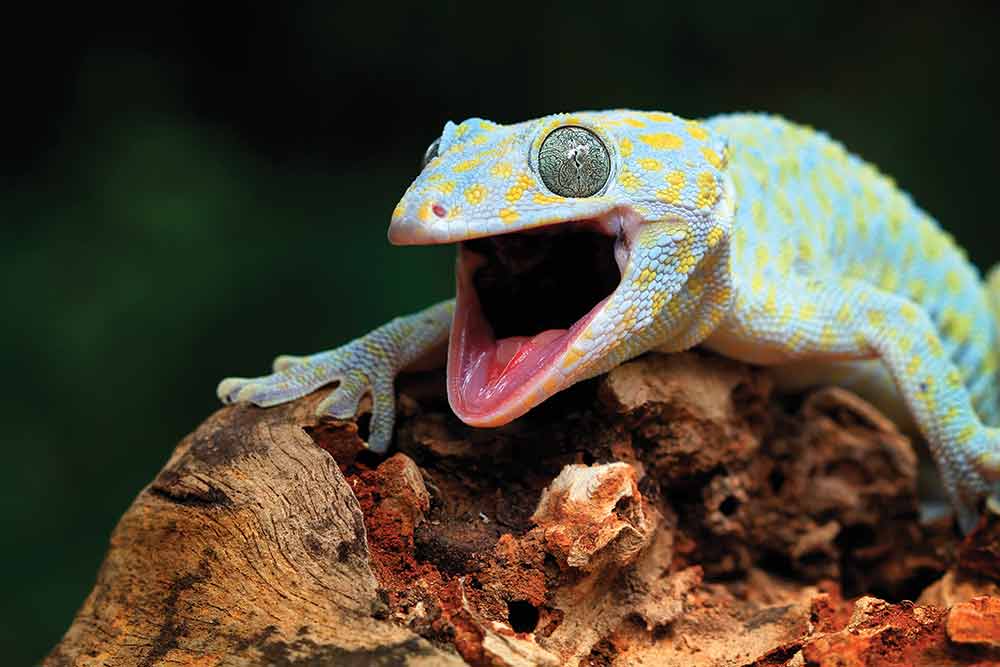Geckos are some of the most beautiful lizards and these are widely captive-bred.
Geckos are some of the most interesting lizards and some are often the widest kept among reptile keepers. Some in the family are widely studied in science for their adhesive toe pad capabilities. For reptile keepers, the geckos are often the most sought after lizard species because of their interesting looks, wide eyes and sometimes bizarre colorations, not to mention that many in the family can lick their eyeballs, they are just so cool.
Here we present care, enclosure requirements and feeding for eight of the most popular geckos: Crested gecko, gargoyle gecko, knob-tailed gecko, leopard gecko, lined day gecko, mossy prehensile-tailed gecko, New Caledonian giant gecko, and Tokay gecko. These species are widely captive bred and can be acquired at most reptile stores, reptile shows and direct from breeders online.
1: Tokay Gecko (Gekko gecko)
The tokay gecko was one of the first gecko species kept in captivity, long before the crested gecko and leopard gecko burst onto the reptile scene. The gecko, native to Southeast Asia, is one of the few kept by reptilekeepers that have a propensity to bite and fight back. They are known to be aggressive, and there are plenty of YouTube videos showing the gecko fighting back and even attacking predators such as tree snakes.
While they do have an aggressive disposition, some keepers have had success calming this species down, as much as a tokay gecko can be calmed down. The nocturnal tokay, called “tuko” in the Philippines because of the telltale vocalizations that sound like “tukooo, tukooo” are harvested in large numbers for the so-called traditional medicine trade in China and elsewhere. They are fortunately, also widely captive-bred for those who can make the commitment to keep them.
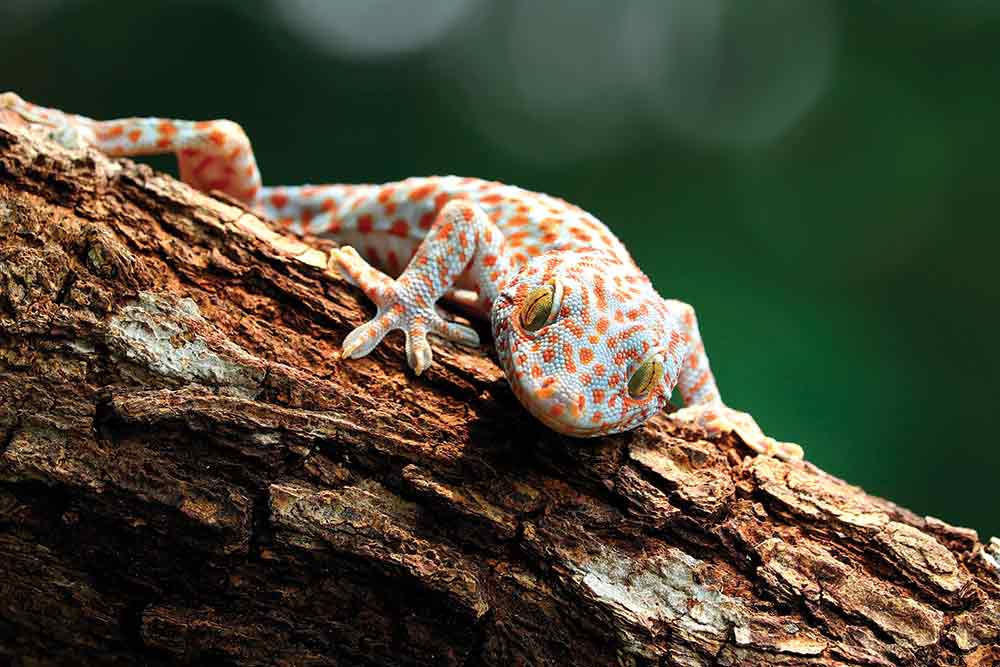
Tokay gecko. Photo by Lauren Suryanata/Shutterstock
Tokay Gecko Enclosure
You can keep a single male or a single male and a female in a 4′ x 2′ x 2′ enclosure. This offers plenty of room for your tokay’s to roam about. Mimic their natural environment as best as possible and ensure there are plenty of hides in the enclosure. Generously outfit the enclosure with live and artificial plants as well as the commercial driftwood and cork bark that is available from most reptile product manufacturers.
Tokay Gecko Substrate
Tokay geckos like it humid. As such, ensure that the enclosure and substrate in which you house the gecko can retain humidity. A good tokay gecko substrate can include cypress mulch and orchid bark, as well as coco husk and spaghnum moss. A three to four inch layer of substrate, misted often, but not so much to create a wet or damp environment, will ensure humidity is ideal. Target a humidity range between 60 and 80 percent.
Tokay Gecko Temperature/Lighting
The ideal daytime temperature range for the tokay gecko’s enclosure is between 80 and 85 degrees Fahrenheit. Nighttime temperatures can drop to the mid 70s. A thermometer is essential to ensure that the temperatures are ideal for this species. Keep a basking spot between 90 and 105 degrees Fahrenheit. You can use ceramic heat emitters or the correct red light bulb for the size of the enclosure to maintain the correct night time heat. During the 12 to 14 hours of daylight, this species is usually asleep, but ensure the enclosure has a daylight and night cycle. The tokay gecko is a Ferguson Zone 1 reptile. It is crepuscular or shade dweller. Choose a UVB light that has a UVI Zone Range of 0 to 0.7 with a maximum UVI Zone range of 0.6 to 1.4 at the basking area, which should be about 8 inches above the basking area. For more on reptile lighting and UVB, visit Reptile Lighting Information.
Feeding Your Tokay Gecko
Feed your tokay gecko three times a week with a variety of feeder insects such as crickets, mealworms, Dubia roaches and waxworms, hornworms and silkworms. Some folks feed them small mice, but they can get all their nutrients from feeder insects, gut loaded and properly dusted with a vitamin/calcium supplement. Add a water dish to the enclosure as well. The gecko may or may not drink from it, but it will help with humidity, as will daily misting.
Ideal Keeper/Handling
The tokay gecko is for expert keepers only. They aren’t all warm and fuzzy like a leopard gecko or a crested gecko, nor are they as delicate as some of the day geckos. They are brutish and will bite you when you least expect it. But they are a colorful and beautiful gecko species. They are my favorite of the geckos only because I remember hearing them often when visiting the Philippines. Ensure your tokay gecko has a beautiful naturalistic terrarium and enjoy your lizard as a display animal rather than one that you handle on a daily basis. While there may be some timid individuals out there, many are not, and won’t hesitate to bite and hang onto your skin.
2: Gargoyle Gecko (Rhacodactylus auriculatus)
The gargoyle gecko is a popular gecko amongst reptile keepers. Widely captive bred, the gargoyle gecko, like the crested gecko, is native to the islands of New Caledonia. Its range however is smaller, restricted to Grand Terre on the main island of New Caledonia.
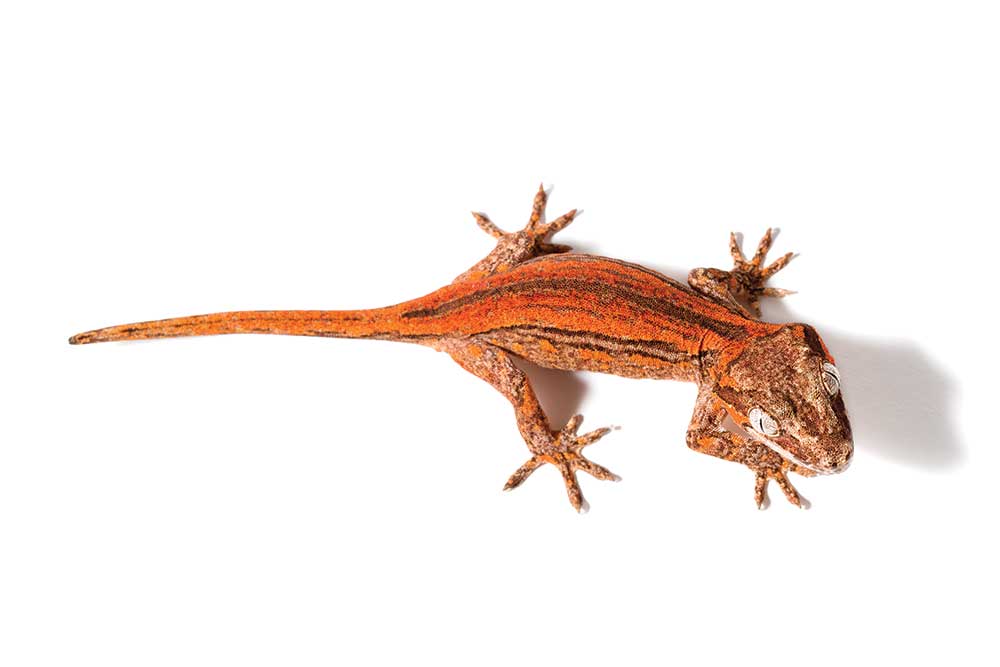
Gargoyle gecko. Photo by Marlonneke Willemsen/Shutterstock
Gargoyle Gecko Enclosure
House your single gargoyle gecko in a minimum 36″ x 18″ x 18″-inch glass terrarium with a screen top.
A collection of a single male and two or three females must be in a larger glass enclosure with a screen top.
Gargoyle Gecko Substrate
The simplest substrate for your gargoyle gecko enclosure is commercially available reptile carpet. If you are going to create a naturalistic enclosure (which is ideal) you can use peat moss-based substrate as well as coconut coir that is available as compressed bricks. Mix it with 50 percent clean soil that will enable you to grow live plants. Ideal plants include small ficus benjamina, dracaena and pothos.
Cork bark added to the enclosure will give your gargoyle gecko a good climbing platform, as well as dried wood branches that can provide perches and a rest area for your gecko.
Gargoyle Gecko Temperature/Lighting
Your gargoyle gecko should be maintained at a temperature of around 75 to 84 degrees Fahrenheit (23.9 to 28.9 degrees Celsius) with an average temperature of 80 degrees Fahrenheit (26.7 degrees Celsius) ideal. If you live in an area that can maintain these temperatures, then supplemental heating is not required, provided the nighttime temperatures don’t fall into the 40s. These geckos are more heat tolerant and cold tolerant than crested geckos, and if you do supplement with a heat pad, make certain there is a cool side to the enclosure so your gecko can thermoregulate if it needs to. Humidity should be kept at around 60 to 65 percent. You can achieve this by misting the cage every day, depending on the overall humidity in the room in which your gargoyle gecko lives. Lightly mist the inside of the enclosure with water droplets that will evaporate within 24 hours. The gargoyle gecko is a Ferguson Zone 2 reptile. It is a partial sun/occasional basker. Choose a UVB light that has a UVI Zone Range of 0.7 to 1.0 with a maximum UVI Zone range of 1.1 to 3.0 at the basking area. For more on reptile lighting and UVB, visit Reptile Lighting Information
Feeding Your Gargoyle Gecko
Feed your gargoyle geckos two to three times a week with any of the commercially available gecko foods for fruit eating geckos. Some of these foods can be mixed with water (others are gels)and placed in the refrigerator, changing out any uneaten food every two to three days. Crickets should be gut loaded and dusted with calcium and Vitamin D3 prior to feeding them to your lizard. You can gut load your crickets with leafy vegetables, carrots, or the commercially available cricket foods.
Ideal Keeper/Handling
The gargoyle gecko is an ideal reptile for those who enjoy a beautiful-looking lizard with exceptional colorations and patterns. They are a bit less flightly than some other lizards in this grouping, and unlike the crested gecko, if the gargoyle gecko drops or loses its tail, it will grow back after several months. If you enjoy occasionally handling a lizard and can adhere to the relatively straightforward care requirements, Rhacodactylus auriculatus could be a great addition to your collection. These lizards with the proper care, can live upwards of 20 years in captivity.
3: Lined Day Gecko (Phelsuma lineata)
The lined day gecko is named as such due to the lines that run down the side of its body. An excellent display animal that is active during the day, Phelsuma lineata is small in size, similar to that of the gold dust day gecko, about 4 to 5 inches in total length. It is native to eastern Madagascar.
Lined Day Gecko Enclosure
House your single lined day gecko in a minimum 12 x 12 x 18-inch vertical enclosure, set up as a bioactive enclosure with live plants including a cleaning crew of springtails and isopods. Include cork bark, branches and bamboo so your gecko can climb and stay up off the floor of the enclosure.
Lined Day Gecko Substrate
As you set up a bioactive enclosure for your lined day gecko, your substrate should consist of a bioactive substrate that can successfully grow plants to help with the humidity of the enclosure. You can find bioactive substrate from most of the major reptile product manufacturers as well as reptile stores and shows.
Lined Day Gecko Temperature/ Lighting
Lined day geckos require daytime temperatures between 75 and 80 degrees Fahrenheit (23.9 to 26.7 degrees Celsius) with a basking spot of around 90 degrees Fahrenheit (32.2 degrees Celsius). Night time temperatures should stay at around 65 degrees Fahrenheit (18.3 degrees Celsius). A moderate level 5.0 UVB light is essential for this species as well to produce Vitamin D. Mist the enclosure daily to help with humidity as well as to provide water droplets in which the gecko can lap up. You can also add a small water bowl to help with humidity, but the gecko will get its water from the daily misting that you provide.
Feeding Your Lined Day Gecko
Feed your lined day gecko a mix of a quality gecko diet and crickets. Young lizards should be fed extra small-sized (pinhead) crickets or fruit flies until they are large enough to consume 1/4 inch crickets. Dust the crickets with a calcium/multi-vitamin supplement. Commercial gecko diets should be offered according to the package and placed in arboreal food dishes available from the major reptile product manufacturers.
Ideal Keeper/Handling
The lined day gecko is best kept as a display animal as it doesn’t take too well to handling. In fact, it may be a little flightly when handled. Keep the lizard in a bioactive enclosure and you will have a wonderful time observing its behaviors while maintaining a healthy enclosure as well.
4: Leopard Gecko (Eublepharis macularius)
The leopard gecko (Eublepharis macularius) is one of the most popular lizards amongst reptile keepers. The species has been widely captive-bred around the world for more than 35 years and come in a range of colors and patterns. Native to Afghanistan, Iran, Pakistan, India, and Nepal, this reptile is found in rocky and dry grasslands and the desert regions of these countries. These lizards are long lived, with some captive specimens living well into their 20s.
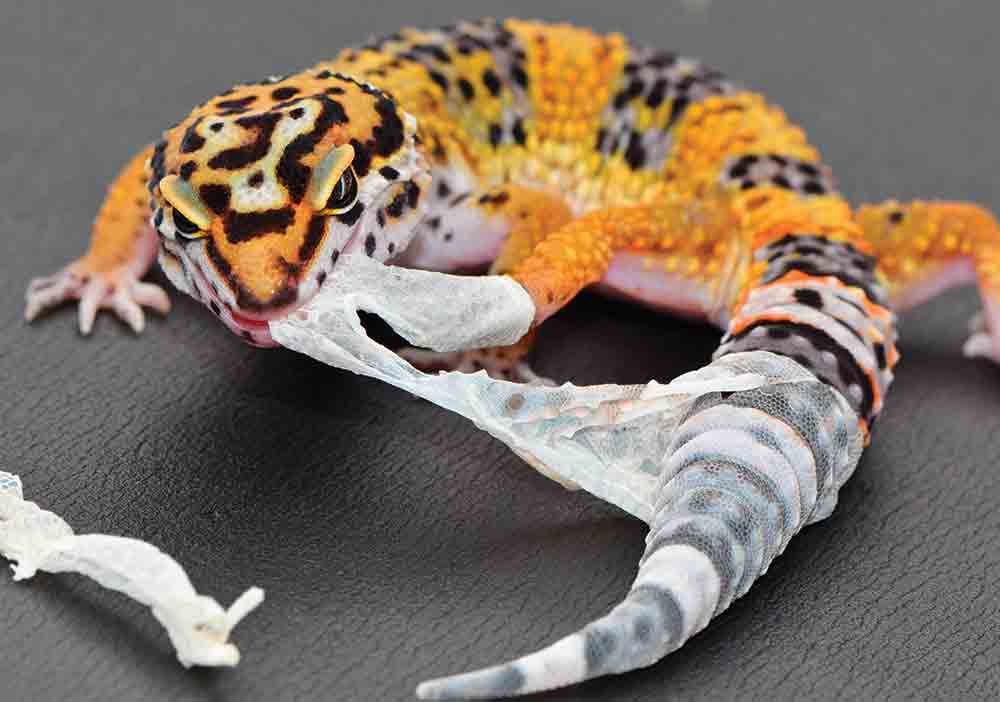
Leopard gecko eating its shed. Photo by Landshark/Shutterstock
Leopard Gecko Enclosure
The leopard gecko is a ground dweller. You can keep a hatchling or juvenile in a 20 gallon long terrarium with a screen top. Adults should be kept in a 36″ x 18″ x 18″ enclosure or larger. Substrate should be pea gravel or flat stones. Add some artificial plants and a hide on the warm end and cool end.
Leopard Gecko Lighting/Temperature
Leopard geckos need Vitamin D3 and this can be accomplished with dusting food items with Vitamin D3 supplements and/or a UVB lamp at the proper light intensity for leopard geckos. There are two trains of thought on the use of UVB lighting. While UVB lighting is not required for these reptiles to survive, this lighting does provide some advantages that are great for their immune system and overall health, according to studies. Create a temperature gradient on one side of the enclosure to ensure that your leopard gecko has the capability to move from the hot area (80 to 85 degrees Fahrenheit or 26.7 to 29.4 degrees Celsius) of the enclosure to the cool area (75° to 80°F, 23.9° to 26.7°C) when needed. The leopard gecko is a Ferguson Zone 1 reptile. It is a partial sun/occasional basker. Choose a UVB light that has a UVI Zone Range of 0 to 0.7 with a maximum UVI Zone range of 0.6 to 1.4 at the basking area. For more on reptile lighting and UVB, visit Reptile Lighting Information. Consult the manufacturer websites which will provide you the proper solution for your reptile and its enclosure.
Feeding Your Leopard Gecko
Leopard geckos can take live gut-loaded crickets dusted with vitamins and calcium supplements. They will also eat mealworms. In addition, you can also feed them commercially prepared foods specifically designed for leopard geckos. These foods often are made with complete nutrition in mind. Your reptile store sells gut loading foods for your feeders. This ensures that your reptiles get good nutrition as well. Make sure the water bowl has fresh water daily, and keep it shallow so your gecko can crawl out if it goes in.
Ideal Keeper/Handleability
The leopard gecko is ideal for those who like to occasionally interact with their reptiles. They tolerate occasional handling, and some even learn to be hand fed. With proper husbandry, these reptiles make great companions to reptile lovers. The leopard gecko might be the most popular lizard amongst reptile keepers. Properly cared for, they can live very long, with some living 20 plus years.
5: Crested Gecko (Correlophus ciliatus)
The crested gecko (Correlophus ciliatus) is one of those amazing lizards that not only looks good, but makes an amazing pet. This reptile, up until 1994, was thought to have gone extinct in its native New Caledonia. A storm hit the island when the reptile, also known as the eyelash gecko, was rediscovered. Now it is one of the most widely captive bred lizards in the world, with a variety of colorations and patterns available that make this gecko a living work of art.
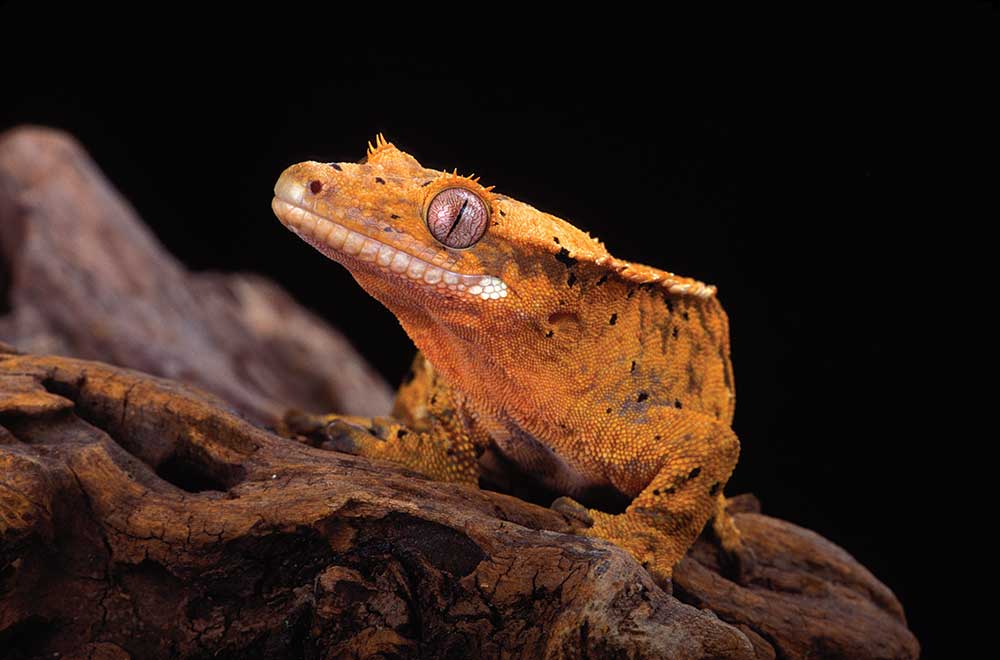
Crested gecko. Photo by Audrey Snider Bell
Crested Gecko Enclosure
Crested geckos do well in enclosures that are tall rather than long. You can house a male and female crested gecko in a minimum 20 gallon tall, glass enclosure. These reptiles require 50 to 70 percent humidity. Buy a hygrometer and test humidity daily. If you live in a warm area that has high humidity all year round, consider keeping your crested gecko in a screened enclosure. Substrate can be as simple as using reptile carpet. It is easy to clean. For a more realistic look, you can use sphagnum moss and mulch-type substrates or coconut fiber mixed with clean soil. Because these reptiles spend a vast majority of their time above ground, provide plenty of dried wood branches criss crossed in the enclosure that enables them to rest. Provide plenty of foliage.
Crested Gecko Substrate
For ease of use, reptile carpet from the major manufacturers is the easiest choice as these reptiles spend most of their time off the substrate. A peat moss based soil mix also works well, just make sure it is free from perlite. If you go the bioactive route with your crested gecko enclosure, consider coconut fiber that is mixed 50 percent with clean soil as a base for growing live plants.
Crested Gecko Temperature/Lighting
Keep your crested gecko in temperatures between 78 to 82 degrees Fahrenheit (25.6 to 27.8 degrees Celsius) during the day. At night, temperatures in the low 70s are good. You can achieve the ideal temperatures using a low watt incandescent bulb or ceramic heat emitter housed in a reflective fixture. Place this on one top of the screen top. This enables the crested gecko to thermoregulate. Conversely you can also use an adhesive-backed heat pad or heat tape regulated by a thermostat. Whichever heating solution you choose, make sure the bottom of the enclosure is cooler than the top.
The crested gecko is a Ferguson Zone 1 reptile. It is a partial sun/occasional basker. Choose a UVB light that has a UVI Zone Range of 0 to 0.7 with a maximum UVI Zone range of 0.6 to 1.4 at the basking area. For more on reptile lighting and UVB, visit Reptile Lighting Information
.
Feeding Your Crested Gecko
Commercially available crested gecko foods are the most popular foods for these omnivores. These are available as powders that you mix with water, as well as ready to eat gels. You can also feed your crested geckos crickets, roaches, waxworms, and silkworms. If you are to feed your cresties an insect diet, feed crickets three times a week, dusted with a vitamin/mineral supplement that contains calcium and vitamin D3. And make sure you also feed them crested gecko foods that are available at your local reptile store or online. The crested gecko can live just fine with one of the commercially prepared crested gecko foods from the various manufacturers, provided they eat it. Some prefer live crickets and mealworms. Keep a shallow water dish filled with fresh water in your gecko’s enclosure. Contrary to popular belief, the crested gecko does and will drink out of the water dish. Mine is suspended with the food bowl. If you live in a dry area, mist the enclosure nightly so it can lap up the water droplets.
Ideal Keeper/Handling
Crested geckos are ideal for those who have been keeping reptiles for years, as well as those who are new to reptile keeping, provided that you read up on how to properly care for these geckos prior to purchasing one. Unlike the green anole or the day geckos, crested geckos can tolerate occasional handling, and some will even feed right out of your hand. The crested gecko is a long lived reptile, with many that are properly cared for living 15 to 20 years.
6: New Caledonian Giant Gecko (Rhacodactylus leachianus)
The New Caledonian giant gecko is widely captive bred, has unique and beautiful colorations and is one of the largest geckos kept by reptile keepers, growing to more than a foot in length. Known to live more than 20 years in captivity, the New Caledonian giant gecko are comprised of two subspecies; the Grand Terre Island locality giant gecko (R. l. leachianus) and the smaller Henkels’ giant gecko (R. l. henkeli) found on Pine Island. The Henkel’s giant gecko grows to between 9 and 12 inches in length. Both types are heavy bodied geckos with short tails.
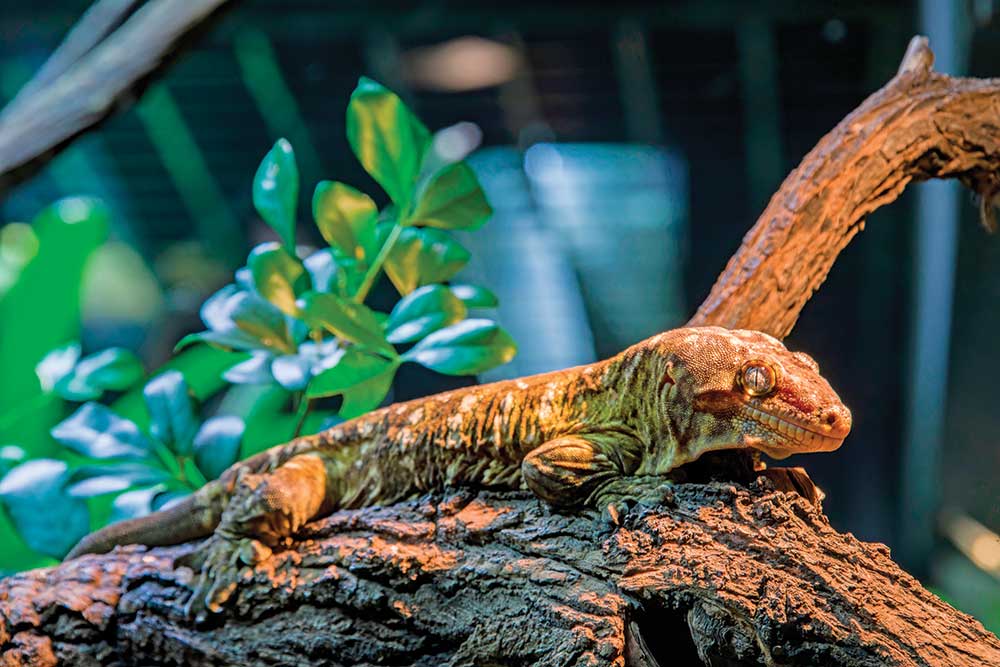
New Caledonian giant gecko. Photo by Danny Ye/Shutterstock
New Caledonian Giant Gecko Enclosure
You can keep a single adult individual in a vertical 4′ x 2′ x 4′-inch tall enclosure with a screen top. Hatchlings and younger geckos can be kept in smaller enclosures, keeping in mind that they will need to go into a larger enclosure as they mature. Outfit the enclosure with plenty of branches and perches for climbing, as well as hides, such as cork bark tubes (which they can also use for climbing and resting, PVC pipe, bamboo and live or artificial plants to keep the enclosure as realistic as possible.
A hide box that doubles as a humidity box is also essential for this species. Humidity should be maintained between 50 and 75 percent. Mist the walls of the enclosure daily to achieve the proper humidity. The soil and plants can be misted as well. Just ensure that the enclosure is not overly wet. Damp is fine. Spot clean the enclosure when the it gets soiled. Clean the enclosure completely at least once a month.
New Caledonian Giant Gecko Substrate
Coconut fiber, organic soil and peat-based potting soil are all great substrates for the New Caledonian giant gecko. These substrates will help to retain humidity in your gecko’s enclosure. With hatchlings and young geckos, you can use paper towels as a substrate. Get on a changing schedule for your substrate so it remains as clean as possible all the time.
New Caledonian Giant Gecko Temperature/Lighting
Temperatures should be kept in the high 70s to lower 80s Fahrenheit during the day and the low 70s at night. These geckos are nocturnal. To achieve the nighttime temperatures of the low 70s, you can use an appropriately-sized ceramic heat emitter for the enclosure. Invest in a quality hygrometer/thermometer to monitor the humidity and temperature. You can keep a light on during the day on a timer and set it to turn off when the sun goes down wherever you may be.The New Caledonian giant gecko is a Ferguson Zone 2 reptile. It is a partial sun/occasional basker. Choose a UVB light that has a UVI Zone Range of 0.7 to 1.0 with a maximum UVI Zone range of 1.1 to 3.0 at the basking area. For more on reptile lighting and UVB, visit Reptile Lighting Information
Feeding Your New Caledonian Giant Gecko
The New Caledonian giant gecko is an omnivore and should be fed a diet of live foods such as crickets and dubia roaches dusted in a multivitamin and Vitamin D3/calcium supplement, as well as commercial gecko foods for fruit eating geckos. Feed the adult geckos two to four crickets or roaches a week. Because the New Caledonian giant gecko is an arboreal species, a feeding platform is essential for the gecko foods. Feed them fresh fruit (bananas, pears, grapes, mangoes, smashed up and placed in the feeding dish) each week as well.
Ideal Keeper/Handling
The New Caledonian giant gecko can be a flightly gecko but with short stints of handling for a few weeks, your gecko may learn that you aren’t a threat and can be handled even more. This of course depends on the individual animal. The New Caledonian giant gecko is also vocal at night when it is active. Be prepared to hear strange noises in the night!
7: Mossy Prehensile-tailed Gecko (Rhacodactylus chahoua)
The mossy prehensile-tailed gecko has become one of the most popular geckos amongst intermediate lizard keepers. The mossy prehensile-tailed gecko is semi-arboreal, nocturnal and eats some of the same foods as the crested gecko. It can live upward of 20 to 25 years in captivity, and can partially regenerate its tail when dropped.
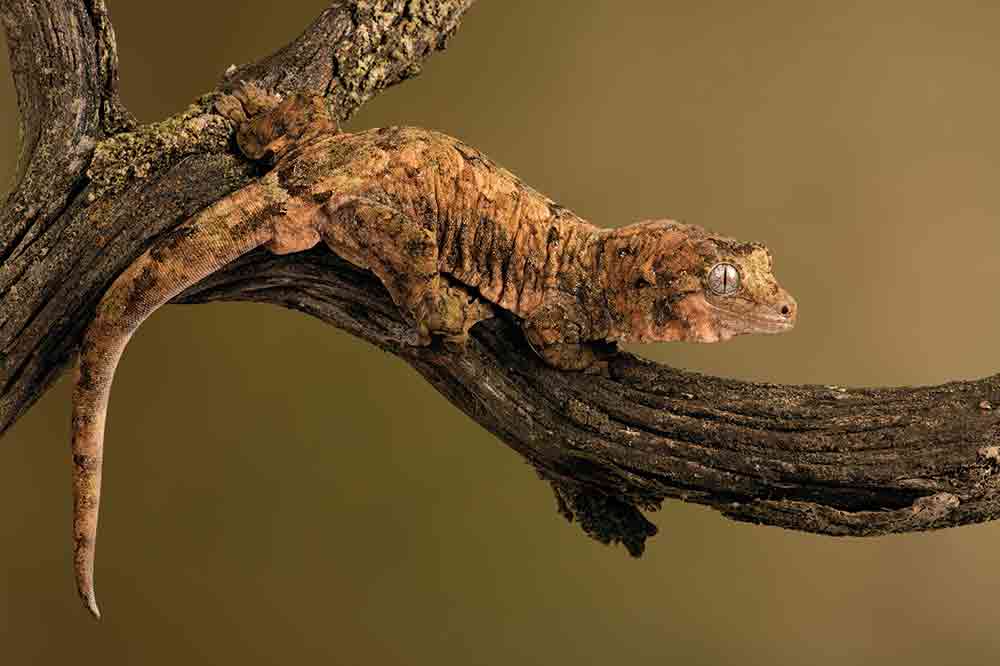
Mossy prehensile tail gecko. Photo by Dave M. Hunt Photography/Shutterstock
Mossy Prehensile-tailed Gecko Enclosure Tips
The mossy prehensile-tailed gecko should be housed in tall enclosures rather than long enclosures. A minimum 36″ x 18″ x 36-inch, glass enclosure is ideal for a single individual, with a larger 24″x 24″x 48″-inch enclosure ideal for a breeding pair. Buy a hygrometer and test humidity daily as this gecko requires humidity, generally between 60 and 75 percent. If you live in a warm area that has high humidity all year round, consider keeping your gecko in a screened enclosure. Mist the enclosure daily to ensure that the humidity stays at this level. Live plants such as pothos can also help with humidity. Check ReptilesMagazine.com for a selection of live plants for your reptiles. Include cork bark, grape vine, bamboo, and other materials that will enable your gecko to climb and perch above ground.
Mossy Prehensile-tailed Gecko Substrate
Coconut fiber, organic soil and peat-based potting soil are all great substrates for your gecko. These substrates will help to retain humidity in your gecko’s enclosure. With hatchlings and young geckos, you can use paper towels as a substrate. Get on a changing schedule for your substrate so it remains as clean as possible all the time. You can mist the substrate to help retain humidity, but don’t mist it so much it gets soaking wet. Mist the sides and plants in the enclosure daily so your gecko can lap up the droplets in its enclosure. This is how it drinks water.
Mossy Prehensile-tailed Gecko Temperature/Lighting
Temperatures should be kept between 72 and 78 degrees Fahrenheit during the day and the low 70s at night. These geckos are nocturnal. To achieve the nighttime temperatures of the low 70s, you can use an appropriately-sized ceramic heat emitter for the enclosure. Invest in a quality hygrometer/thermometer to monitor the humidity and temperature.
You can keep a light on during the day on a timer and set it to turn off when the sun goes down. The mossy prehensile-tailed gecko is a Ferguson Zone 1 reptile. It is a partial sun/occasional basker. Choose a UVB light that has a UVI Zone Range of 0 to 0.7 with a maximum UVI Zone range of 0.6 to 1.4 at the basking area. For more on reptile lighting and UVB, visit Reptile Lighting Information Ensure that one side of the enclosure has a cool spot so your gecko can thermoregulate. In the case of the tall enclosure, this area would be closer to the bottom. You can outfit the bottom with cork bark or some other basking platform that the gecko can use to get away from the heat higher up the enclosure.
Feeding Your Mossy Prehensile-tailed Gecko
The mossy prehensile-tailed gecko is an omnivore and should be fed a diet of live foods such as crickets and dubia roaches dusted in a multivitamin and Vitamin D3/calcium supplement, as well as commercial gecko foods for fruit-eating geckos. Feed the adult geckos 10 to 12 live crickets or roaches two to three times a week. Because the mossy prehensile-tailed gecko is a semi-arboreal species, a feeding platform is essential for the gecko foods. Feed them fresh fruit (bananas, pears, grapes, mangoes, smashed up and placed in the feeding dish) each week as well. They will consume more live insects than fruit based gecko foods and fresh fruits, so keep this in mind as well.
Ideal Keeper/Handling
The mossy prehensile-tailed gecko is a beautiful gecko that is widely captive bred and has care requirements that, while not challenging, must be adhered to, ensuring its proper health. They are a large gecko that can grow to 10 inches in length and can live to 20 years in captivity.
8: Knob-Tailed Gecko (Nephrurus sp.)
Knob-tailed geckos are native to Australia and are so named due to the knob at the end of their tails. In total there are 11 species in the genus and several (Nephrurus amyae, N. wheeleri, N. levis and N. milii) are widely captive breed. They are not a large gecko, with Nephrurus amyae, the largest of the knob-tails, rarely exceeding 6 inches in snout to vent length.
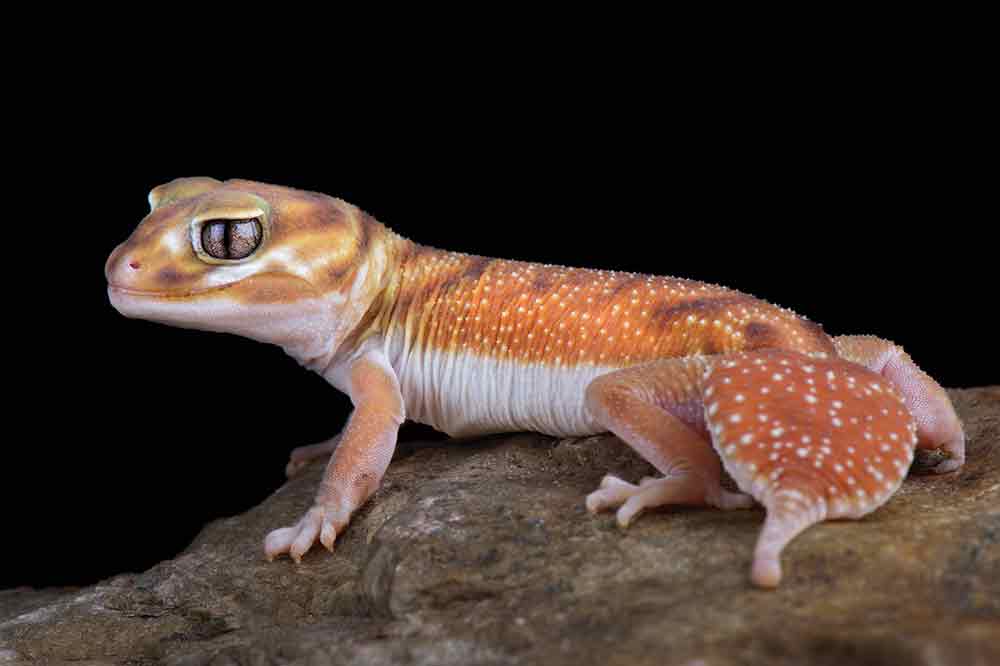
Knob-tailed gecko Photo by reptiles4all/Shutterstock
Knob-Tailed Gecko Enclosure
House your single knob-tailed gecko in a minimum 30″x 12″x 12″ long enclosure or equivalent. These geckos are not climbers so branches and other decor are not needed. What is needed are hides; you can place one hide on one end of the enclosure and a second hide on the other, in a cool spot of the enclosure. Keep the hides smaller and with a single opening for them to crawl in and out of. This ensures a more secure feeling for your gecko. Add a rough rock that will help them keep their nails short.
Knob-Tailed Gecko Substrate
A non-silica-based fine-grain sand is the best substrate for this gecko. Your gecko will create burrows in which to hide in. You can find this type of sand at your local reptile store. Some folks use play sand from the home improvement store. Just make sure it is non-silica based and non-toxic.
Knob-Tailed Gecko Temperature/Lighting
The knob-tailed gecko is a Ferguson Zone 1 reptile. It is a partial sun/occasional basker. Choose a UVB light that has a UVI Zone Range of 0 to 0.7 with a maximum UVI Zone range of 0.6 to 1.4 at the basking area. For more on reptile lighting and UVB, visit Reptile Lighting Information. For heat, an under tank heat element appropriate for the size of the enclosure is ideal. You can also use an overhead ceramic heat emitter as well. Read the package box to ensure the right size emitter. Temperatures on the hot side should be in the upper 80s Fahrenheit, while the cool side is significantly cooler. Ensure the other side of the enclosure is around 70 to 74 degrees Fahrenheit.
With regard to humidity, the smooth-skinned geckos, Nephrurus levis, N. l. pilbarensis and N. deleani require a more humid environment. You can spray the sand near the hide on the cool side as well as inside and atop the hide to ensure adequate humidity. You can also lightly spray around the gecko. For Nephrurus amyae and N. wheeleri, these rough-skinned geckos thrive in dry environments and thus don’t require humid conditions, but they do need water. Spray the walls on the cool side and you can also lightly spray them as well. They will absorb the water.
Feeding Your Knob-Tailed Gecko
Your knob-tailed geckos should be fed live crickets, roaches, mealworms and, sparingly, wax worms that have been dusted with a Vitamin D3/calcium supplement and gut-loaded prior to feeding. You can use fresh vegetables or a commercial gut-loading foods for your feeders. A water dish can alternatively be made available with clean water, and mist the sides of the cool area daily to ensure it has condensation in which the geckos can lap up.
Ideal Keeper/Handling
The knob-tail gecko is an interesting gecko in that it likes to burrow and create tunnels. They are not an arboreal species, so they are more often visible and easy to find in their enclosure. While they are tolerant of handling, they aren’t as friendly as the crested gecko or the leopard gecko. They have a cool look to them and live upward of 10 years or more when cared for properly.
John Virata is editor of REPTILES magazine and ReptilesMagazine.com He has been keeping herps since he was 10 years old. You can reach him at ReptilesEditor@gmail.com.

